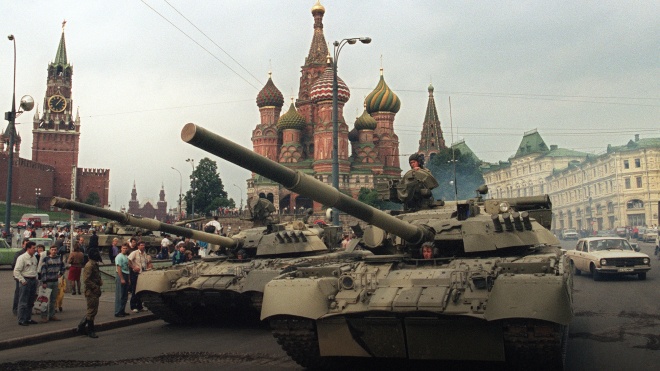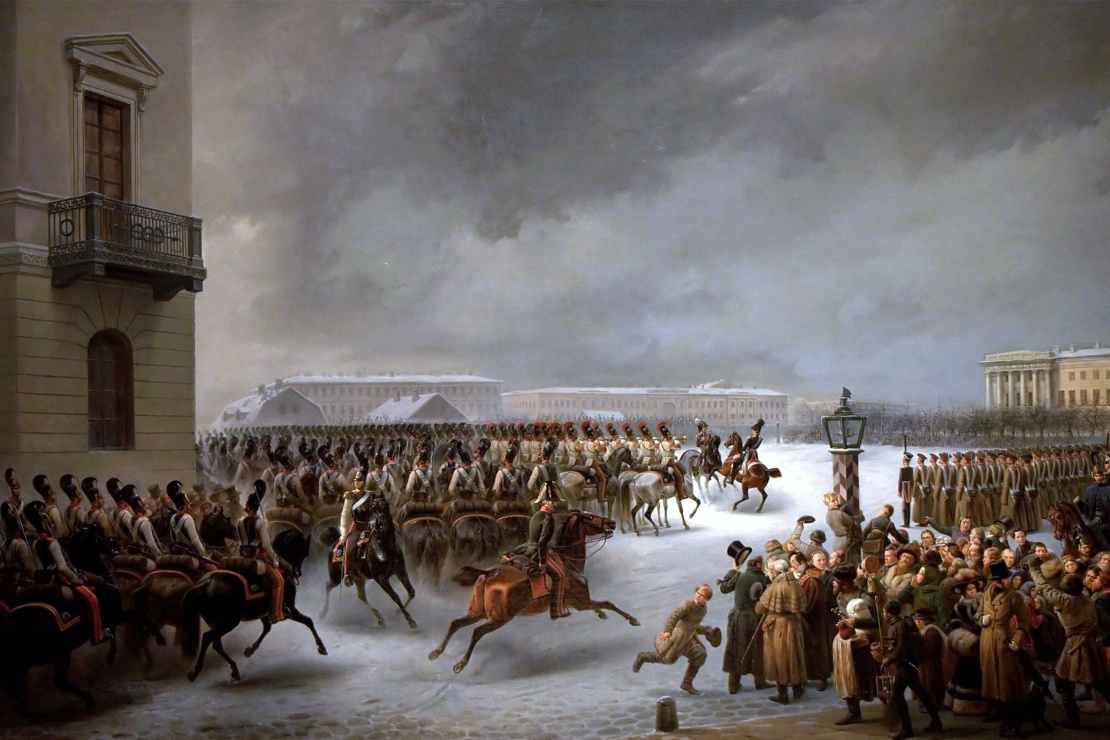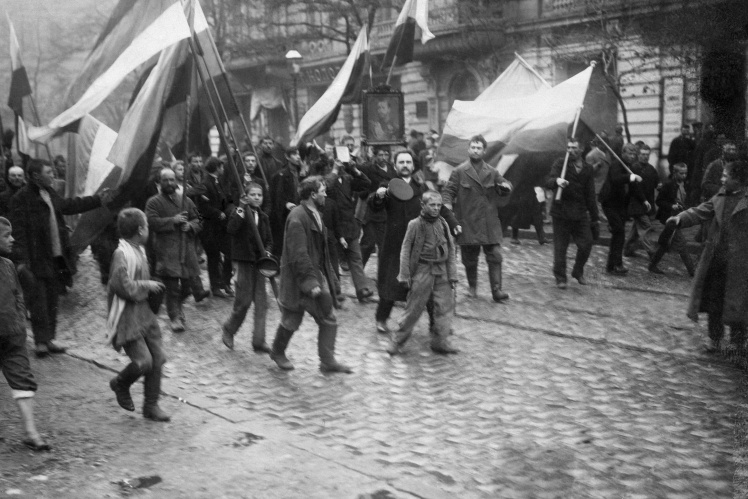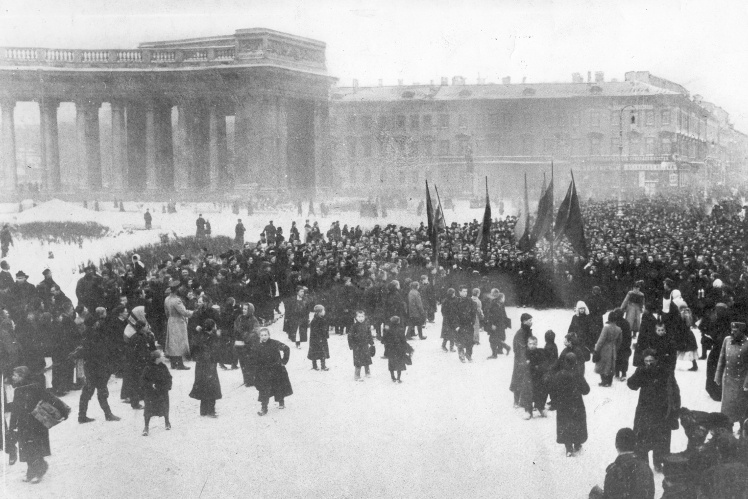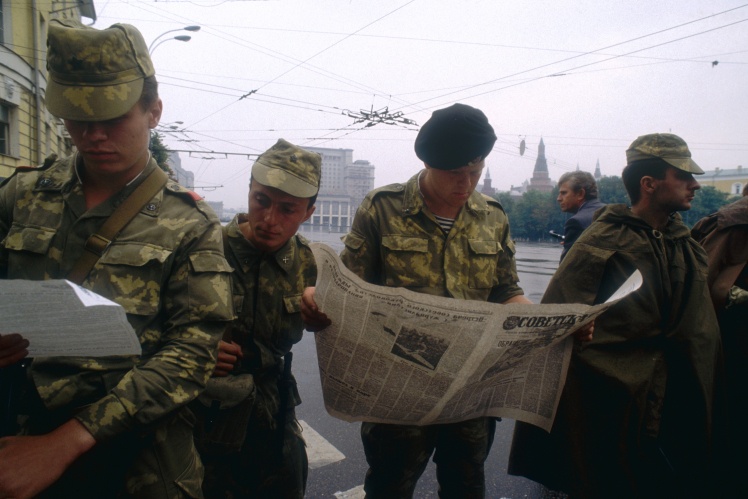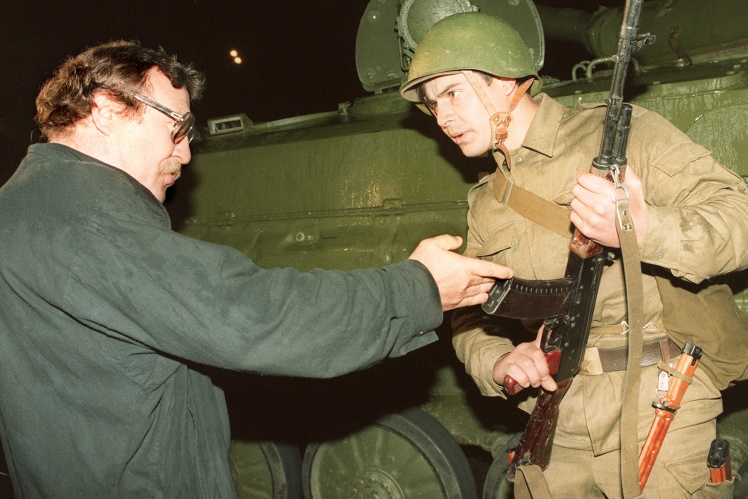Revolt of the Decembrists, 1825.
Background: After the victory in the Napoleonic Wars, Russian noble officers returned from Europe with reformist ideas and the revolutionary slogan "Freedom, equality, fraternity”. The first secret circles of officers who opposed the autocracy and supported the abolition of serfdom as a feudal relic arose in the first half of the 1810s. By the beginning of the 1820s, there were already two large secret societies: the Southern one in Kyiv, which advocated the overthrow of the autocracy and the proclamation of the republic, and the Northern one in St. Petersburg — with more moderate views on the constitutional limitations of the monarchy. After the death of Emperor Alexander I at the end of 1825, there was no single successor to the throne. The conspirators decided to use this to overthrow the absolute monarchy.
Main events: On the morning of December 26, 1825, the conspirators together with loyal military units went to Senate Square in St. Petersburg, where the new emperor Nicholas I was sworn in. However, everything went wrong from the very beginning. Some of the leaders of the Decembrists got scared at the last moment and refused to participate in the uprising. When the insurgents arrived at the square, Nicholas I had already taken the oath. While they stood, not knowing what to do next, the square was surrounded by government regiments. The rebels were offered to surrender, but they refused. A firefight ensued, government troops used artillery. In the evening of the same day, the uprising was suppressed. 1,271 people died in the shooting on Sennaya Square, more than 900 of them were civilians, including 150 children who came to watch the swearing-in ceremony. A few days after the coup attempt in St. Petersburg, the Southern Society of the Decembrists organized an uprising of the Chernihiv regiment, but the government troops crushed them on the way to Zhytomyr. After that, a trial began, about 600 people were on the dock. Five Decembrists were sentenced to death, 120 were sent to hard labor in Siberia.
The Decembrists on Senate Square, painting by Georg Wilhelm Thimm, 1853.
Wikimedia
What happened next: Nicholas I began to “tighten the nuts” and harshly suppress all hints of a change in the state system. Already in 1826, the Third Department of the Chancellery appeared — a secret police that monitored the mood in society and identified the disaffected. In the same year, a new censorship statute was issued, which was nicknamed "cast iron". It was forbidden to print almost anything that had any political basis.
After the "Spring of Nations" in Europe, Nicholas I began to pursue an even more brutal domestic policy, fearing the penetration of “revolutionary contagion”. Since 1848, he forbade the entry of foreigners, and the departure of his subjects abroad. Those who were abroad at that moment had to return immediately so as not to lose their citizenship and property in Russia. These prohibitions were valid until the death of Nicholas I in 1855.
The emperor fought the revolutionary movement not only in Russia, but also in Europe in general. In 1849, he sent troops to suppress a revolution in Hungary that wanted to break away from the Austrian Habsburg Empire. It was during the reign of Nicholas I that the nickname "Gendarmerie of Europe" was established for Russia.
Nicholas I informs his guards about the uprising in Poland, colored engraving by Georg Benedict Wunder, 1830s.
Wikimedia
Nicholas I slightly improved the position of serf peasants: he forbade landowners to separate family members when selling and arbitrarily send peasants to hard labor, serfs got the right to own land, conduct business, and could move relatively freely. However, he never dared to abolish serfdom, considering it too radical a reform. This was followed by his successor Alexander II in 1861. However, even some of his contemporaries called this reform "criminal" and "half-hearted", because little has changed in the situation of the peasants. Except that now they were not called "serfs" but "obliged", but they were also forced to work for the lordship.
Rehearsal of the revolution, 1905.
Background: At the beginning of the 20th century, Russia was on the verge of another economic and political crisis. In order to distract the people from internal problems and raise the prestige of the royal power, one of the ministers proposed to arrange a "small victorious war" with Japan in 1904. However, Russia lost this war. And the internal problems did not disappear anywhere, so the revolutionary sentiments only intensified.
Main events: The first “alarm bell” rang in July 1904, when one of the initiators of the war with Japan, the Minister of Internal Affairs and the head of the Gendarme Corps, Viacheslav Pleve, was killed — a bomb was thrown into his carriage by a Socialist-Revolutionary student. In January 1905, the strikers of the Putilovsky plant in St. Petersburg decided to address a petition to the tsar. However, then-emperor Nicholas II simply left the city. Demonstrators in front of the Zimniy Palace were met by troops who opened fire. According to various sources, then from 130 to 200 people died, and from 300 to 800 were injured. This shooting of a peaceful demonstration went down in history under the name "Bloody Sunday". In the summer, the riots of sailors of the Black Sea Fleet began. In autumn, workersʼ and peasantsʼ demonstrations became so large-scale that the authorities had to make concessions.
Demonstrators with a portrait of Nicholas II in St. Petersburg on Bloody Sunday, January 22, 1905. Demonstration on Nevsky Avenue in St. Petersburg on "Bloody Sunday", January 22, 1905.
Getty Images / «Babel'»
What happened next: In October 1905, Nicholas II issued a manifesto proclaiming civil liberties and reforms to improve the conditions of workers and peasants. But the most important thing is that the creation of the first elected parliament, the State Duma, was announced, which was supposed to take over legislative powers.
The first Duma elections were held in the spring of 1906. Newly elected deputies, in addition to social and economic reforms, immediately began to demand political ones — further limitation of autocracy. Nicholas II did not like this, so in 72 days he dissolved the Duma. The next convocation of the parliament was elected in the spring of 1907, and most of the deputies from the first convocation were forbidden to be re-elected. But the second convocation turned out to be even more radical. If in the first Duma the constitutional democrats had a majority, now the main seats were given to socialists — Bolsheviks, Socialist-Revolutionaries and others. Also, many seats were taken by autonomists — Polish, Ukrainian, Estonian. The Second Duma was dissolved already in June 1907. After that, the electoral legislation was changed: the election procedure was complicated, property requirements were introduced, and the number of deputies from national minorities was reduced. Thus, the first Russian revolution ended in defeat — all real reforms were blocked by Nicholas II.
Nicholas II speaks at the opening session of the first Duma in St. Petersburg, April 27, 1906.
Getty Images / «Babel'»
The real revolution, mutiny and coup, 1917.
Background: In 1914, Russia entered the First World War. At that time, the economic, social and, of course, political crisis was growing in the country. Peopleʼs trust in the autocracy has not existed since 1905. Nicholas II lost his prestige in military circles when he took over the powers of the supreme commander, but he did not prove himself as a commander. Concentrating on the army, the tsar left internal affairs without attention and missed the moment when even the representatives of his closest entourage joined the opposition.
Main events: At the end of February 1917, mass workersʼ strikes began in Petrograd. Soldiers joined them. It all ended with the fact that on March 2, under pressure from the political and military elites, Emperor Nicholas II abdicated, and power passed to the Provisional Government. In August, Russian General Lavr Kornilov organized a march on Petrograd to "bring order to the country." But the attempt failed, and the general was declared a rebel. The Bolsheviks frankly missed the February Revolution — most of them were abroad. However, in the summer of 1917, they joined the political struggle. And on October 25, they staged an armed coup and seized power.
Barricades on Liteiny Avenue in Petrograd during the February Revolution, 1917. Peopleʼs militia patrol in Petrograd during the February Revolution, 1917.
Getty Images / «Babel'»
What happened next: The Bolsheviks managed not only to capture, but also to retain power. Almost immediately, they began to suppress the attempts of the peoples of the former Russian Empire to gain independence. Already in December 1917, the Bolsheviks invaded Ukraine, in 1918 they suppressed the attempts of the Crimean Tatars to turn Crimea into a democratic republic.
Instead of the Russian Empire, the Soviet one appeared, with oppression, repression, censorship and centralization of power. Almost all Soviet dictators threatened the rest of the world. Joseph Stalin together with Hitler unleashed the Second World War. Nikita Khrushchev almost started the Third World War during the Caribbean crisis. Leonid Brezhnev launched the Soviet invasion of Afghanistan, which was planned as a quick victory operation, but dragged on for almost ten years. Yuriy Andropov found himself on the brink of war with the West and shot down a South Korean Boeing with 269 people on board. The nickname "Evil Empire" was glued for the USSR.
August Putsch, 1991.
Background: In the late 1980s, communist regimes began to fall one after another in Europe. The Berlin Wall, which divided Germany for almost thirty years, fell. The USSR was also on the verge of collapse. In March 1990, Lithuania was the first republic to declare independence. In July, Ukraine took the first step towards independence — it announced the Declaration of State Sovereignty. The first and last president of the Soviet Union, Mikhail Gorbachev, agreed to reformat the USSR into a confederation of sovereign states. The corresponding agreement was planned to be signed on August 20, 1991.
Main events: The day before the signing of the treaty, on August 19, the leaders of the party, the army and the KGB formed the State Emergency Committee and tried to remove Gorbachev from power. They declared invalid all decisions of the Soviet republics on sovereignty and independence, banned political parties (except the Communist Party), a number of public organizations and the media. On the same day, thousands of protests began in Moscow. The insurgents dragged several army units into the city, three people died during an attempt to block the military equipment. The recently elected president of the RSFSR, Boris Yeltsin, became the leader of the resistance to the coup. In the evening of August 21, the putsch finally failed.
Soviet soldiers read newspapers during the putsch in Moscow, August 20, 1991. An opponent of the putsch argues with a Soviet soldier in central Moscow, August 20, 1991. An opponent of the putsch tries to throw a Soviet soldier from an armored personnel carrier in the center of Moscow, August 19, 1991.
Getty Images / «Babel'»
What happened next: After the putsch, there was no question of any new alliance agreement. In three days, Ukraine adopted the Act of Independence. By the end of 1991, the president of the USSR, Mikhail Gorbachev, resigned. The RSFSR became the Russian Federation, and its president Yeltsin soon unleashed the tanks in the struggle for power. The formal dissolution of the USSR was formalized by the Council of the Republics on December 26, 1991. Against the background of the collapse, military conflicts began on the territory of the former republics: in 1991 in Nagorno-Karabakh and in 1992 in Transnistria.
During this period, the only ones who tried to save the USSR from collapse were the USA. Nuclear missiles remained on the territory of the new states. So the White House feared that a new post-Soviet dictator might emerge who would rattle the world with nuclear weapons. Such a dictator eventually appeared, but where the USA least expected it — in the Kremlin.
Constitutional crisis, 1993.
Background: After the collapse of the USSR, the Soviet system was still preserved in Russia, where, according to the constitution, the highest power belonged to the parliament. On the other hand, the post of president appeared. At that time, it was held by Boris Yeltsin, and he demanded from the parliament to transfer more powers to him. Deputies led by Ruslan Khasbulatov tried to impeach Yeltsin. On September 21, 1993, Yeltsin dissolved the parliament and called for new elections. The president did not have the authority to do so, and the Constitutional Court declared his decree unconstitutional. And the parliament declared Yeltsinʼs actions a coup dʼétat.
Main events: This led to an armed confrontation in Moscow: an attempt to seize the Ostankino television center and an assault on the parliament building, the White House, with the use of tanks. On October 4, 1993, Khasbulatov and his supporters were arrested. According to official data, 158 people died in the clashes, 130 of them civilians.
Tanks shell the parliament building in Moscow during the constitutional crisis, October 4, 1993.
What happened next: Yeltsin received virtually dictatorial powers for a few months. With his decrees, he canceled the norms of legislation and the constitution in force at that time. He also dismissed the Constitutional Court, which did not support him in the conflict with the parliament. By Yeltsinʼs decree on December 12, 1993, a referendum was held on the new constitution, although the president did not have such powers. In the end, Yeltsin succeeded in adopting a new constitution that greatly expanded his power.
After that, Yeltsin set out to limit the autonomy and suppress attempts at the sovereignty of the regions of the Russian Federation. In the case of Chechnya, this resulted in a military invasion in 1994, which was called "operation to restore constitutional order." It was possible to return Chechnya to the Russian Federation on the second attempt, in 2000, already during the time of Putin, whom Yeltsin appointed as his successor in the post of president. Also, during the years of his rule, Putin made many changes to the Russian constitution, which gave the president even more power and authority.
Translated from Ukrainian by Anton Semyzhenko.
Sooner or later, every dictator will face a rebellion, and we want to face only your donations. Support Babel: 🔸 in hryvnia 🔸 in cryptocurrency 🔸 Patreon 🔸 PayPal: [email protected]
